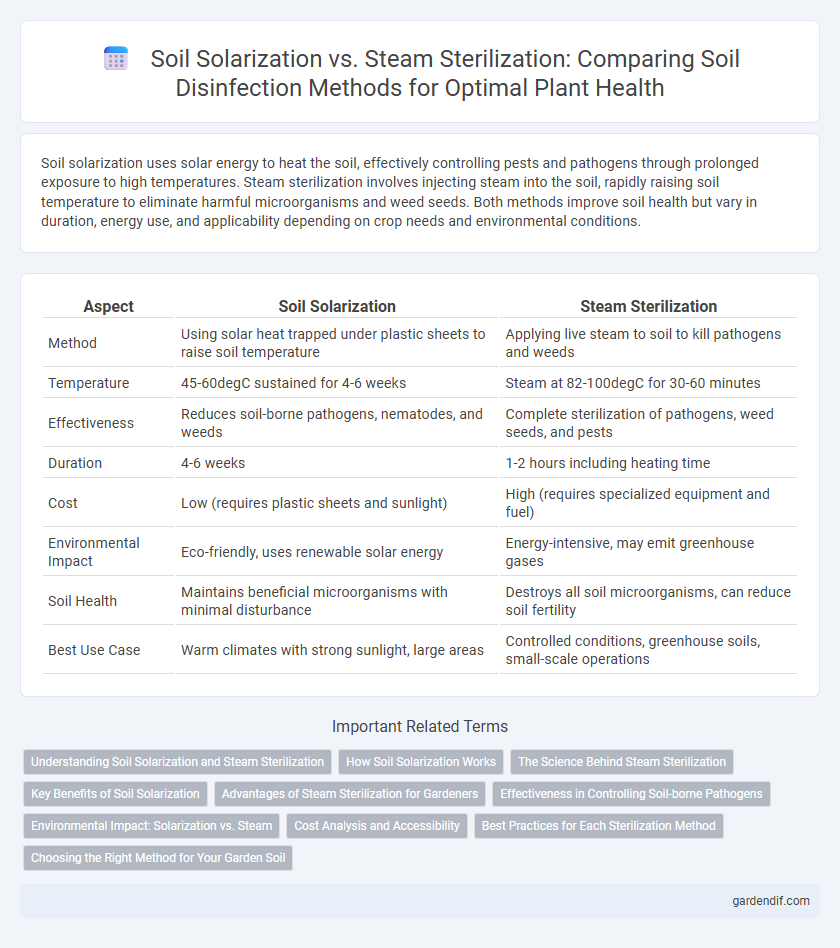
Soil solarization vs Steam sterilization Illustration
Soil solarization uses solar energy to heat the soil, effectively controlling pests and pathogens through prolonged exposure to high temperatures. Steam sterilization involves injecting steam into the soil, rapidly raising soil temperature to eliminate harmful microorganisms and weed seeds. Both methods improve soil health but vary in duration, energy use, and applicability depending on crop needs and environmental conditions.
Table of Comparison
| Aspect | Soil Solarization | Steam Sterilization |
|---|---|---|
| Method | Using solar heat trapped under plastic sheets to raise soil temperature | Applying live steam to soil to kill pathogens and weeds |
| Temperature | 45-60degC sustained for 4-6 weeks | Steam at 82-100degC for 30-60 minutes |
| Effectiveness | Reduces soil-borne pathogens, nematodes, and weeds | Complete sterilization of pathogens, weed seeds, and pests |
| Duration | 4-6 weeks | 1-2 hours including heating time |
| Cost | Low (requires plastic sheets and sunlight) | High (requires specialized equipment and fuel) |
| Environmental Impact | Eco-friendly, uses renewable solar energy | Energy-intensive, may emit greenhouse gases |
| Soil Health | Maintains beneficial microorganisms with minimal disturbance | Destroys all soil microorganisms, can reduce soil fertility |
| Best Use Case | Warm climates with strong sunlight, large areas | Controlled conditions, greenhouse soils, small-scale operations |
Understanding Soil Solarization and Steam Sterilization
Soil solarization uses solar energy to raise soil temperature to 45-60degC for 4-6 weeks, effectively controlling soil-borne pathogens and weeds through thermal disinfection. Steam sterilization involves applying steam at temperatures above 80degC, rapidly eliminating microbes, nematodes, and weed seeds in a shorter time frame, often within hours. Both methods improve soil health and crop yield but differ in energy use, treatment duration, and environmental impact.
How Soil Solarization Works
Soil solarization works by covering moist soil with transparent polyethylene sheets that trap solar radiation, raising the temperature to levels lethal for soil-borne pathogens, weed seeds, and nematodes. Temperatures between 45degC and 60degC sustained for 4 to 6 weeks during peak sunlight are effective in disinfecting the upper soil layers. This eco-friendly method enhances soil health by reducing harmful organisms without chemical inputs, improving crop yield and quality.
The Science Behind Steam Sterilization
Steam sterilization relies on moist heat to eliminate soil-borne pathogens, effectively denaturing proteins and disrupting cellular structures of fungi, bacteria, and nematodes. This process achieves temperatures around 121degC (250degF) under pressure, ensuring deep soil penetration and consistent pathogen control. Compared to soil solarization, steam sterilization provides rapid and uniform sterilization regardless of environmental conditions, making it an efficient method for pathogen eradication in agricultural soils.
Key Benefits of Soil Solarization
Soil solarization offers key benefits such as effective control of soil-borne pathogens, nematodes, and weed seeds through the use of solar heat, which reduces the need for chemical fumigants. This environmentally friendly technique enhances soil health by preserving beneficial microorganisms and improving nutrient availability. Additionally, soil solarization is cost-effective and easy to implement, making it a sustainable choice for pest and disease management in agriculture.
Advantages of Steam Sterilization for Gardeners
Steam sterilization offers gardeners precise control over soil pathogen elimination, achieving temperatures around 100degC that effectively destroy bacteria, fungi, and weed seeds without chemical residues. Unlike soil solarization, steam sterilization can be applied regardless of weather conditions or seasonal sunlight intensity, ensuring consistent soil treatment. This method preserves beneficial soil microorganisms better than chemical fumigants and accelerates soil preparation, enhancing crop health and yield.
Effectiveness in Controlling Soil-borne Pathogens
Soil solarization effectively controls soil-borne pathogens by raising soil temperatures to 45-60degC (113-140degF) for 4-6 weeks, which suppresses fungi, nematodes, and weed seeds through prolonged heat exposure. Steam sterilization achieves higher temperatures above 100degC (212degF) rapidly, eliminating a broader spectrum of pathogens, including resistant fungal spores and bacterial populations, within hours. While steam sterilization offers immediate and thorough pathogen eradication, soil solarization presents an energy-efficient, sustainable alternative for long-term pathogen suppression in suitable climates.
Environmental Impact: Solarization vs. Steam
Soil solarization uses solar energy to raise soil temperatures, reducing pathogens and pests without chemical inputs, making it an eco-friendly and sustainable method. In contrast, steam sterilization consumes significant amounts of fossil fuel energy, leading to higher greenhouse gas emissions and a larger carbon footprint. Solarization's reliance on renewable energy sources minimizes environmental impact, while steam sterilization contributes to air pollution and energy resource depletion.
Cost Analysis and Accessibility
Soil solarization offers a cost-effective and accessible method for sterilizing soil by utilizing solar energy, requiring minimal equipment and no fuel expenses, making it ideal for small-scale and resource-limited farmers. Steam sterilization involves higher initial investment in equipment and operational costs, including fuel or electricity, which can be prohibitive for widespread use in developing regions. Accessibility is influenced by climate suitability for solarization and availability of steam sterilization technology, with solarization favored in sunny, warm areas and steam sterilization preferred for rapid, large-scale applications in industrial farming.
Best Practices for Each Sterilization Method
Soil solarization requires covering moist soil with clear polyethylene sheets for 4 to 6 weeks during peak sunlight to achieve temperatures above 45degC, effectively controlling soil-borne pathogens and nematodes. Steam sterilization is best applied using saturated steam at 82-93degC for 30-60 minutes, ensuring even heat penetration to eliminate fungi, bacteria, and weed seeds without harming soil structure. Proper moisture content--around 50% field capacity--is critical for both methods to maximize microbial elimination while preserving beneficial soil organisms.
Choosing the Right Method for Your Garden Soil
Soil solarization uses solar heat to effectively reduce soil-borne pathogens, weeds, and nematodes through plastic tarping, making it an energy-efficient and eco-friendly choice for warm climates. Steam sterilization involves applying high-temperature steam to eliminate harmful organisms and is ideal for controlled environments or smaller garden beds requiring rapid, thorough disinfection. Selecting between solarization and steam sterilization depends on factors like climate, scale of the garden, desired treatment speed, and availability of resources for effective soil pathogen control.
Soil solarization vs Steam sterilization Infographic

 gardendif.com
gardendif.com